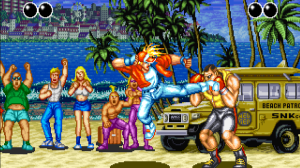Daggerheart combines mechanics from a variety of different tabletop RPG systems in a mostly successful way that should appeal to players used to playing Dungeons & Dragons. Earlier this week, Darrington Press released the open playtest beta for Daggerheart, its new heroic fantasy tabletop RPG that’s clearly meant as a D&D alternative. The game uses an asymmetric game system with players making checks using Duality Dice, a pair of D12s, and the GM playing using a separate set of rules. In the early pages of the Daggerheart playtest, the designers list a number of other games as influences and it’s obvious that some mechanics were pulled from those games and adjusted for use in Daggerheart. To be clear – this isn’t a criticism of Daggerheart’s design; many games pull mechanics from inspiration and adjust them, but many observers if there’s too many competing systems at play for Daggerheart to work.
Videos by ComicBook.com
I had the chance to play Daggerheart last summer, so I approached the open playtest not from the perspective of “how does it play” but rather “how can I run it.” For reference, I’m basically a Forever DM and have run thousands of sessions of Dungeons & Dragons and Pathfinder since I started playing tabletop RPGs almost a decade ago. However, my experience running more narrative-focused games are rather limited (I usually just adjust D&D rules to match the needs of whatever story I’m running), so I was a bit apprehensive of running a system that leaned more heavily into Powered by the Apocalypse-style narrative systems. I was also very curious how my players, all of whom had played D&D and Pathfinder together for years, enjoyed the more free-flowing style of game.
It turns out, Daggerheart seems to be the right fit for my table. When we sat down to run through an abridged version of Daggerheart’s playtest version, all three players had created their characters without complaint and were ready to play after a brief rundown of the game. One thing I noticed when the players introduced their characters is that all of them leaned into the more fantastical character-building options even though they had mostly stuck to traditional fantasy races during their various Dungeons & Dragons’ campaigns. I think the character building prompts encouraged players to look at different archetypes for their characters, although we didn’t have much time to really incorporate backstories into the game.
It took a couple of rounds for both the players and I to get used to the new mechanics of Daggerheart, and there were still parts of the game that sort of got brushed over in our first run through. Because the players had played together at the table for so long, there wasn’t much issue with them sharing the spotlight without the use of an initiative system. In fact, all three players expressed enjoyment that they could bounce around in combat, either choosing to wait to use a specific ability without “holding an action” or being able to instantly react when their character unexpectedly found themselves in danger.
Things that the players also seemed to enjoy was the more free-flowing pace of the world and the instant impact their choices made on the narrative and the impact. The Sablewood became a slowly petrifying forest thanks to one narrative prompt, while a conversation with a dwarf NPC took a dark turn when the Fungril Druid mentioned that his kind “eats” dead humanoids. The players were used to a more “set” world and they expressed that they enjoyed the more collaborative experience, in part because they felt it took some pressure off me as a GM.
One continued worry my players have had for years is that the time investment I make as a DM is unbalanced compared to the time they invest as players. It’s become harder to run a full-fledged custom D&D campaign as my other responsibilities have grown over the years, and honestly, it’s nice to be able to toss questions like “what do I find on the thief’s body” back at my players and let them have some additional narrative ownership beyond making choices in a scenario.
Within combat, it did take both players and myself some time to really understand “what” all could be done in an action and I think there could be a little more clarity within the ruleset. For instance, a player wanted to drink a potion, activate a class ability, and make an attack in a single action – I ruled that they could do the drink a potion and activate a class ability as one action and then do a subsequent action to make an attack, but I either couldn’t find the rules that adjudicated this or they weren’t really clearly defined.
On the GM side, I struggled a bit using the action tracker properly, although this was at least partially due to both combats having a series of solid rolls by the players that resulted in a series of successes with hope that left me with a ton of action markers to use on a turn, more than the number of adversaries I had in play. Once all my Fear was spent and adversaries were activated, I didn’t have much choice but to turn things back over to the players, although I only felt that it really dragged the narrative within combat one time during the session. Switching over to the duality-focused system of passing or failing checks with additional consequences was also pretty easy, although admittedly I had already switched to more checks with narrative consequence in my D&D games long before Daggerheart. It felt a little weird using a D20 and a traditional advantage/disadvantage system from the GM side when my players were using a very different check system, but I didn’t mind the asymmetry once I got used to it. Having what’s essentially a different ruleset than the players was uncomfortable at first, but only because it felt like I had to learn two sets of rules – one to help the players with their actions, and another to keep the game flowing.
Mechanics that I feel still need some work include the Experiences system which my players didn’t understand at first and then ignored for most of the campaign. Given that Experiences is activated using their Hope currency, they felt that adding a +1 or +2 to a roll didn’t have the same impact as other abilities activated by Hope. I also felt like the Fear resource used by players probably needs a bit more heft outside of combat. I enjoyed that I could spend Fear to add some additional in-combat effects, but it honestly just seemed like a pool that slowly built up over the course of roleplaying and non-combat and then was turned into another resource to track during the big endgame combat encounter. Personally, I’ll probably try using Fear as some kind of soft timer within the session – using it to trigger some sort of extra complication once the Fear pool reaches a certain point.
The monster statblocks were … fine for the most part, although I didn’t like that the monsters in the Playtest had almost all their cool abilities locked behind a GM Move that needed to be activated using Fear points. Because Fear is only generated by a player character rolling with fear, I think there’s a temptation to default to “this monster attacks, and then this monster attacks” style of gameplay if you’re trying to save your Fear resource for later on into the game which is narratively boring and a bit too much like the worst kinds of 5E combats. There’s ways to mitigate this, of course, such as by making fighting to the death not the point of a combat session, but the game has the same potential pratfalls that plague D&D 5E.
One side-note: I feel like the Daggerheart playtest went as well as it did because of the Daggerheart Nexus created by Demiplane. The character sheet has a lot of resources to manage (HP, Armor Slots, Stress, Hope; not to mention class features like the Seraph’s prayer die) and Demiplane’s character sheet handled most of that for the players in a decently intuitive way. The players had some minor quibbles with some of Demiplane’s UI, but overall the use of the digital tools really added to and simplified the experience and allowed them to dive into the game a lot easier.
In general, Daggerheart utilizes a lot of subsystems, some of which feel contradictory or novel, but they actually seem to work together pretty well, at least during the two and a half hours I ran. The game seems to aim at the “rule-medium” crowd, with more rules to keep track of than something like Monster of the Week but less to keep track of than Dungeons & Dragons or Pathfinder. I think that folks who already are used to and enjoy the narrative style of RPG will probably bounce off of Daggerheart pretty quickly, but I do think that the game will find an audience with the large segment of players who have only played Dungeons & Dragons 5E and tend to shy away from other games.
My players have generally been uninterested in any style of game that isn’t Dungeons & Dragons for the usual reasons – they don’t want to learn a new ruleset, they’re only interested in the specific kind of fantasy story Dungeons & Dragons tells, and they’re comfortable enough with the system that it doesn’t detract from the more important social time that D&D sessions offer. For them, Daggerheart seemed to be a viable alternative, something that mostly touched on all the same beats as Dungeons & Dragons but was distinct and different enough to be refreshing.








